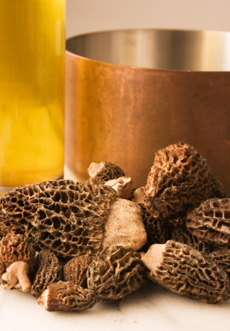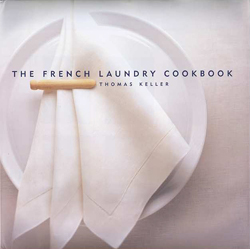
 Fire up the stove! Exotic, delicious wild morels are a fleeting spring vegetable (though available dried year-round). Photo by Yin Yang | IST.
Fire up the stove! Exotic, delicious wild morels are a fleeting spring vegetable (though available dried year-round). Photo by Yin Yang | IST.
|
KAREN HOCHMAN is Editorial Director of THE NIBBLE.
|
|
June 2008
|
 |
Meet The Morel
Part I: An Unforgettable Wild Mushroom
CAPSULE REPORT: All mushrooms are not created equal. The morel is one of the more flavorful and it’s certainly exciting to look at. A perennial favorite of French chefs, it grows wild in the woods in the spring, and is available in dried and canned forms year-round. This is Part I of a three-part article. Use the index below to click among the sections.
Before the month is over, it’s time to carpe diem and meet the morel. Along with asparagus, fiddlehead ferns and ramps, it’s a stunning vegetable that is with us for a fleeting time each spring. Although it’s available in dried and canned forms year-round, if you like mushrooms, there is nothing like the smoky, earthy, meaty flavor of fresh morels.
The morel (morille, on French menus) is one of the easiest mushroom varieties to recognize: It’s the “cone head” of mushrooms. Its conical cap is honeycombed—some call it coral or brain-like. You can’t mistake it for any other kind of mushroom. There are more than 20 different varieties of morel, so the cap can range from creamy beige to gray to yellow and golden to brown and brown/black; they are highly aromatic. The caps vary in their design; some are quite stunning. The stems are smooth and white and can be one to four or five inches tall. The entire fungus, including the stem, is edible and can be cooked whole.
There are three types of edible morel in North America: the Yellow Morel (Morchella esculenta), the Black Morel (Morchella elata, also called M. conica and M. angusticeps) and the Half-Free Morel (M. semilibera). There are also a couple of poisonous mushrooms that resemble morels, so don’t be elated by a discovery in the woods.
Enjoying Morels
Morels add a very distinctive, meaty flavor profile to almost any meal, from simple breakfast egg dishes to elegant multi-course dinners. From the same family as truffles, morels are a delicacy packed with flavor. They need little, if any, embellishment. Morels are also visually stunning; you add the “wow” factor to any dish, just by being clever enough to include these wonders. Morel mushrooms are a luxury ingredient for special occasions, but affordable enough to grace everyday dishes.
“Morels alone can be the star of a meal,” notes Justin Marx, CEO of MarxFoods.com, a purveyor of specialty foods. “One of my favorite ways to cook them is roasted whole with heirloom potatoes and onions. They’re so flavorful, that they make a truly special wild ingredient that will stimulate any meal. I really look forward to this time of year.” He also cites a favorite recipe from Thomas Keller’s The French Laundry Cookbook, scallops with morel and asparagus purée. Morels are a popular ingredient in soups and sauces (dried morels, which plump up in liquid, are perfect for this purpose [see photo of dried morels below). |

Thomas Keller is one of many top chefs who enjoys cooking with morels, using it in recipes in The French Laundry Cookbook. |
But cooks go crazy during morel season. As with truffles, one simply never tires of fresh morel flavor. Consider them:
- In a side dish, roasted or combined with other vegetables (morels pair famously with both asparagus and leeks)
- Added to salads, especially with a sliced breast of chicken (but morels must always be cooked—never serve them raw or nibble on a raw morel as you cook)
- Sautéed as a topping for almost any meat (beef, lamb, loin of pork poultry)
- Ditto, with fish and shellfish
- As a flavorful stuffing
- Over scrambled eggs for brunch
- As a filling in savory crêpes
- In pasta and risotto—and to make one heck of a mushroom pizza
- As an exotic appetizer—wrapped in puff pastry or fried
Continue to Part II: Buying & Preparing Morels
Return To Article Index, Above
Lifestyle Direct, Inc. All rights reserved. Images are the copyright of their respective owners.

|



